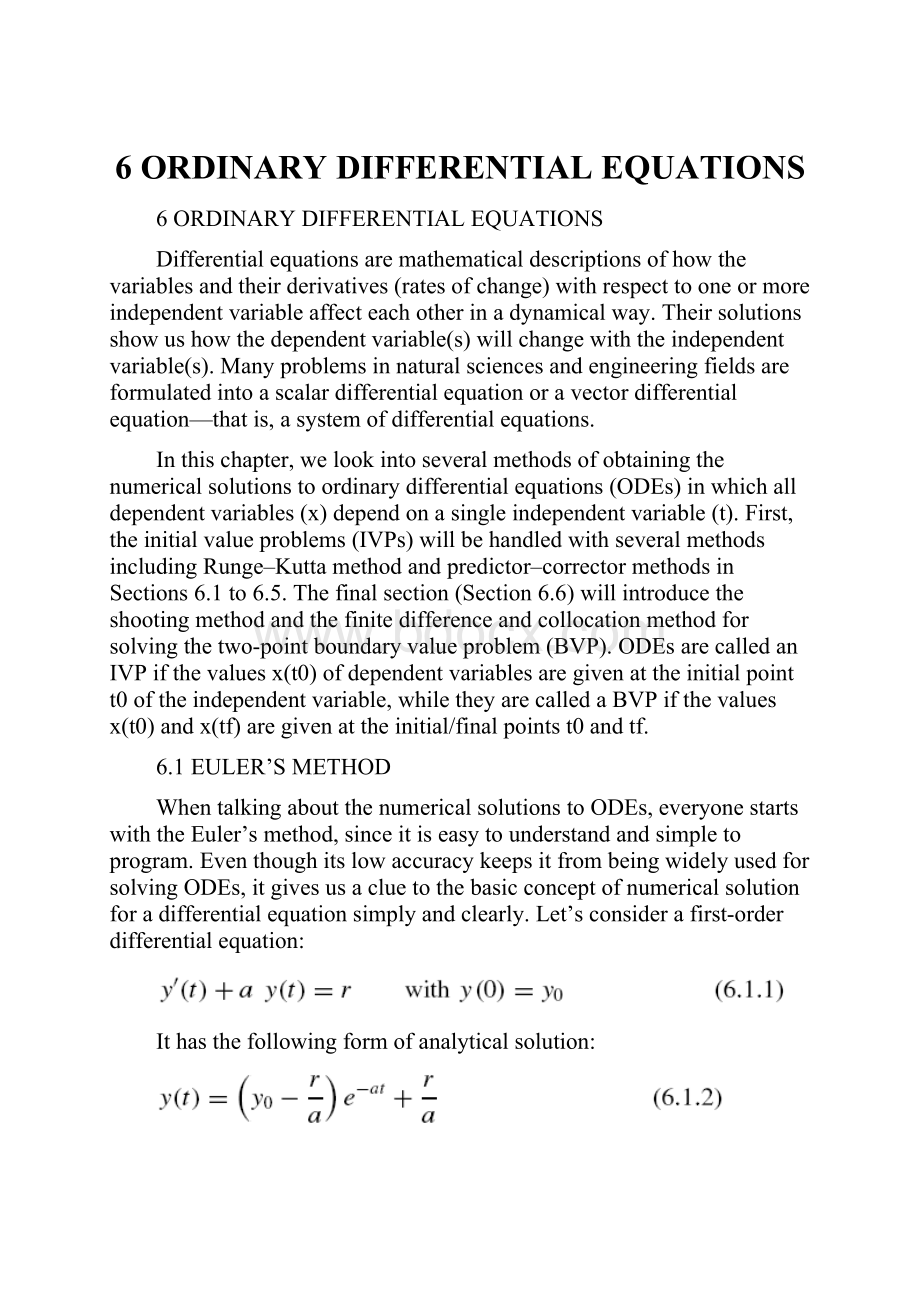6 ORDINARY DIFFERENTIAL EQUATIONS.docx
《6 ORDINARY DIFFERENTIAL EQUATIONS.docx》由会员分享,可在线阅读,更多相关《6 ORDINARY DIFFERENTIAL EQUATIONS.docx(112页珍藏版)》请在冰豆网上搜索。

6ORDINARYDIFFERENTIALEQUATIONS
6ORDINARYDIFFERENTIALEQUATIONS
Differentialequationsaremathematicaldescriptionsofhowthevariablesandtheirderivatives(ratesofchange)withrespecttooneormoreindependentvariableaffecteachotherinadynamicalway.Theirsolutionsshowushowthedependentvariable(s)willchangewiththeindependentvariable(s).Manyproblemsinnaturalsciencesandengineeringfieldsareformulatedintoascalardifferentialequationoravectordifferentialequation—thatis,asystemofdifferentialequations.
Inthischapter,welookintoseveralmethodsofobtainingthenumericalsolutionstoordinarydifferentialequations(ODEs)inwhichalldependentvariables(x)dependonasingleindependentvariable(t).First,theinitialvalueproblems(IVPs)willbehandledwithseveralmethodsincludingRunge–Kuttamethodandpredictor–correctormethodsinSections6.1to6.5.Thefinalsection(Section6.6)willintroducetheshootingmethodandthefinitedifferenceandcollocationmethodforsolvingthetwo-pointboundaryvalueproblem(BVP).ODEsarecalledanIVPifthevaluesx(t0)ofdependentvariablesaregivenattheinitialpointt0oftheindependentvariable,whiletheyarecalledaBVPifthevaluesx(t0)andx(tf)aregivenattheinitial/finalpointst0andtf.
6.1EULER’SMETHOD
WhentalkingaboutthenumericalsolutionstoODEs,everyonestartswiththeEuler’smethod,sinceitiseasytounderstandandsimpletoprogram.EventhoughitslowaccuracykeepsitfrombeingwidelyusedforsolvingODEs,itgivesusacluetothebasicconceptofnumericalsolutionforadifferentialequationsimplyandclearly.Let’sconsiderafirst-orderdifferentialequation:
Ithasthefollowingformofanalyticalsolution:
whichcanbeobtainedbyusingaconventionalmethodortheLaplacetransformtechnique.However,suchaniceanalyticalsolutiondoesnotexistforeverydifferentialequation;evenifitexists,itisnoteasytofindevenbyusingacomputerequippedwiththecapabilityofsymboliccomputation.Thatiswhyweshouldstudythenumericalsolutionstodifferentialequations.
Then,howdowetranslatethedifferentialequationintoaformthatcaneasilybehandledbycomputer?
Firstofall,wehavetoreplacethederivativey’(t)=dy/dtinthedifferentialequationbyanumericalderivative(introducedbefore),wherethestep-sizehisdeterminedbasedontheaccuracyrequirementsandthecomputationtimeconstraints.Euler’smethodapproximatesthederivativeinEq.(6.1.1)withEq.(5.1.2)as
andsolvesthisdifferenceequationstep-by-stepwithincreasingtbyheachtimefromt=0.
Thisisanumericsequence{y(kh)},whichwecallanumericalsolutionofEq.(6.1.1).
Tobespecific,lettheparametersandtheinitialvalueofEq.(6.1.1)bea=1,r=1,andy0=0.Then,theanalyticalsolution(6.1.2)becomes
y(t)=1−e−at(6.1.5)
andthenumericalsolution(6.1.4)withthestep-sizeh=0.5andh=0.25areaslistedinTable6.1anddepictedinFig.6.1.WemakeaMATLABprogram“nm610.m”,whichusesEuler’smethodforthedifferentialequation(6.1.1),actuallysolvingthedifferenceequation(6.1.3)andplotsthegraphsofthenumericalsolutionsinFig.6.1.
%nm610:
Eulermethodtosolvea1st-orderdifferentialequation
clear,clf
a=1;r=1;y0=0;tf=2;
t=[0:
0.01:
tf];yt=1-exp(-a*t);%Eq.(6.1.5):
trueanalyticalsolution
plot(t,yt,’k’),holdon
klasts=[842];hs=tf./klasts;
y
(1)=y0;
foritr=1:
3%withvariousstepsizeh=1/8,1/4,1/2
klast=klasts(itr);h=hs(itr);y
(1)=y0;
fork=1:
klast
y(k+1)=(1-a*h)*y(k)+h*r;%Eq.(6.1.3):
plot([k-1k]*h,[y(k)y(k+1)],’b’,k*h,y(k+1),’ro’)
ifk<4,pause;end
end
end
Figure6.1ExamplesofnumericalsolutionobtainedbyusingtheEuler’smethod.
Thegraphsseemtotellusthatasmallstep-sizehelpsreducetheerrorsoastomakethenumericalsolutionclosertothe(true)analyticalsolution.But,aswillbeinvestigatedthoroughlyinSection6.2,itisonlypartiallytrue.Infact,atoosmallstep-sizenotonlymakesthecomputationtimelonger(proportionalas1/h),butalsoresultsinratherlargererrorsduetotheaccumulatedround-offeffect.Thisiswhyweshouldlookforothermethodstodecreasetheerrorsratherthansimplyreducethestep-size.
Euler’smethodcanalsobeappliedforsolvingafirst-ordervectordifferentialequation
whichisequivalenttoahigh-orderscalardifferentialequation.Thealgorithmcanbedescribedby
andiscastintotheMATLABroutine“ode_Euler()”.
function[t,y]=ode_Euler(f,tspan,y0,N)
%Euler’smethodtosolvevectordifferentialequationy’(t)=f(t,y(t))
%fortspan=[t0,tf]andwiththeinitialvaluey0andNtimesteps
ifnargin<4|N<=0,N=100;end
ifnargin<3,y0=0;end
h=(tspan
(2)-tspan
(1))/N;%stepsize
t=tspan
(1)+[0:
N]’*h;%timevector
y(1,:
)=y0(:
)’;%alwaysmaketheinitialvaluearowvector
fork=1:
N
y(k+1,:
)=y(k,:
)+h*feval(f,t(k),y(k,:
));%Eq.(6.1.7)
end
6.2HEUN’SMETHOD:
TRAPEZOIDALMETHOD
Anothermethodofsolvingafirst-ordervectordifferentialequationlikeEq.(6.1.6)comesfromintegratingbothsidesoftheequation.
Ifweassumethatthevalueofthe(derivative)functionf(t,y)isconstantasf(tk,y(tk))withinonetimestep[tk,tk+1),thisbecomesEq.(6.1.7)(withh=tk+1−tk),amountingtoEuler’smethod.Ifweusethetrapezoidalrule(5.5.3),itbecomes
function[t,y]=ode_Heun(f,tspan,y0,N)
%Heunmethodtosolvevectordifferentialequationy’(t)=f(t,y(t))
%fortspan=[t0,tf]andwiththeinitialvaluey0andNtimesteps
ifnargin<4|N<=0,N=100;end
ifnargin<3,y0=0;end
h=(tspan
(2)-tspan
(1))/N;%stepsize
t=tspan
(1)+[0:
N]’*h;%timevector
y(1,:
)=y0(:
)’;%alwaysmaketheinitialvaluearowvector
fork=1:
N
fk=feval(f,t(k),y(k,:
));y(k+1,:
)=y(k,:
)+h*fk;%Eq.(6.2.3)
y(k+1,:
)=y(k,:
)+h/2*(fk+feval(f,t(k+1),y(k+1,:
)));%Eq.(6.2.4)
end
But,theright-handside(RHS)ofthisequationhasyk+1,whichisunknownattk.Toresolvethisproblem,wereplacetheyk+1ontheRHSbythefollowingEuler’sapproximation:
sothatitbecomes
ThisisHeun’smethod,whichisimplementedintheMATLABroutine“ode_Heun()”.Itisakindofpredictor-and-correctormethodinthatitpredictsthevalueofyk+1byEq.(6.2.3)attkandthencorrectsthepredictedvaluebyEq.(6.2.4)attk+1.ThetruncationerrorofHeun’smethodisO(h2)(proportionaltoh2)asshowninEq.(5.6.1),whiletheerrorofEuler’smethodisO(h).
6.3RUNGE–KUTTAMETHOD
AlthoughHeun’smethodisalittlebetterthantheEuler’smethod,itisstillnotaccurateenoughformostreal-worldproblems.Thefourth-orderRunge–Kutta(RK4)methodhavingatruncationerrorofO(h4)isoneofthemostwidelyusedmethodsforsolvingdifferentialequations.Itsalgorithmisdescribedbelow.
where
Equation(6.3.1)isthecoreofRK4method,whichmaybeobtainedbysubstitutingSimpson’srule(5.5.4)
intotheintegralform(6.2.1)ofdifferentialequationandreplacingfk+1/2withtheaverageofthesuccessivefunctionvalues(fk2+fk3)/2.Accordingly,theRK4methodhasatruncationerrorofO(h4)asEq.(5.6.2)andthusisexpectedtoworkbetterthantheprevioustwomethods.
Thefourth-orderRunge–Kutta(RK4)methodiscastintotheMATLABroutine“ode_RK4()”.Theprogram“nm630.m”usesthisroutinetosolveEq.(6.1.1)withthestepsizeh=(tf−t0)/N=2/4=0.5andplotsthenumericalresulttogetherwiththe(true)analyticalsolution.
function[t,y]=ode_RK4(f,tspan,y0,N,varargin)
%Runge-Kuttamethodtosolvevectordifferentialeqny’(t)=f(t,y(t))
%fortspan=[t0,tf]andwiththeinitialvaluey0andNtimesteps
ifnargin<4|N<=0,N=100;end
ifnargin<3,y0=0;end
y(1,:
)=y0(:
)’;%makeitarowvector
h=(tspan
(2)-tspan
(1))/N;t=tspan
(1)+[0:
N]’*h;
fork=1:
N
f1=h*feval(f,t(k),y(k,:
),varargin{:
});f1=f1(:
)’;%(6.3.2a)
f2=h*feval(f,t(k)+h/2,y(k,:
)+f1/2,varargin{:
});f2=f2(:
)’;%(6.3.2b)
f3=h*feval(f,t(k)+h/2,y(k,:
)+f2/2,varargin{:
});f3=f3(:
)’;%(6.3.2c)
f4=h*feval(f,t(k)+h,y(k,:
)+f3,varargin{:
});f4=f4(:
)’;%(6.3.2d)
y(k+1,:
)=y(k,:
)+(f1+2*(f2+f3)+f4)/6;%Eq.(6.3.1)
end
%nm630:
Heun/Euer/RK4methodtosolveadifferentialequation(d.e.)
clear,clf
tspan=[02];
t=tspan
(1)+[0:
100]*(tspan
(2)-tspan
(1))/100;
a=1;yt=1-exp(-a*t);%Eq.(6.1.5):
trueanalyticalsolution
plot(t,yt,’k’),holdon
df61=inline(’-y+1’,’t’,’y’);%Eq.(6.1.1):
d.e.tobesolved
y0=0;N=4;
[t1,ye]=oed_Euler(df61,tspan,y0,N);
[t1,yh]=ode_Heun(df61,tspan,y0,N);
[t1,yr]=ode_RK4(df61,tspan,y0,N);
plot(t,yt,’k’,t1,ye,’b:
’,t1,yh,’b:
’,t1,yr,’r:
’)
plot(t1,ye,’bo’,t1,yh,’b+’,t1,yr,’r*’)
N=1e3;%toestimatethetimeforNiterations
tic,[t1,ye]=ode_Euler(df61,tspan,y0,N);time_Euler=toc
tic,[t1,yh]=ode_Heun(df61,tspan,y0,N);time_Heun=toc
tic,[t1,yr]=ode_RK4(df61,tspan,y0,N);time_RK4=toc
ComparisonofthisresultwiththoseofEuler’smethod(“ode_Euler()”)andHeun’smethod(“ode_Heun()”)isgiveninFig.6.2,whichshowsthattheRK4methodisbetterthanHeun’smethod,whileEuler’smethodistheworstintermsofaccuracywiththesamestep-size.But,
Figure6.2Numericalsolutionsforafirst-orderdifferentialequation.
intermsofcomputationalload,theorderisreversed,becauseEuler’smethod,Heun’smethod,andtheRK4methodneed1,2,and4functionevaluations(calls)periteration,respectively.
(cf)Notethatafunctioncalltakesmuchmoretimethanamultiplicationandthusthenumberoffunctioncallsshouldbeacriterioninestimatingandcomparingcomputationaltime.
TheMATLABbuilt-inroutines“ode23()”and“ode45()”implementtheRunge–Kutt